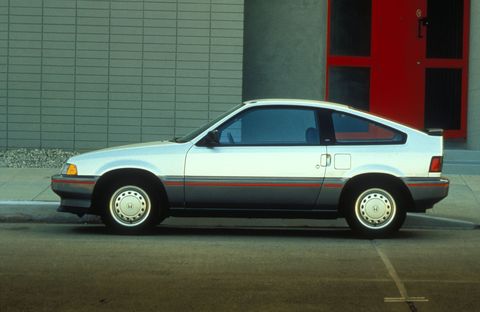The World Needs a New CRX
The Honda Civic CRX was a great idea when it first appeared as a 1984 model. It was a travesty when, after two brilliant generations, Honda replaced it with the misbegotten Del Sol for 1992. And it’s exactly the car that Honda should be building right now.
“The more brilliant a concept, the harder it is to make it better,” wrote our Road & Track ancestors back in the December 1987 issue. “(S)ince its 1984 introduction, we’ve been in love with this little sweetheart. We’ve called it a New Wave sports car. We’ve commissioned a Spyder version. We’ve analyzed in everything from stock form to boy-racer trim. Now, best yet, a sparkling black CRX Si has arrived right here at our offices.”
With gas prices hitting spit-take heights and every new vehicle now seemingly the size of a Hyatt, what we need is a lightweight coupe that gets ridiculously good mileage without any compromise in dynamic satisfaction.
The brilliance of the CRX was that it wasn’t just the Si. At the bottom of the range was the HF – introduced for 1985 – which used a 1.5-liter, eight-valve four rated at a low-spunk 58 horsepower (1986 spec) but was EPA-rated at an astonishing 49 mpg in the city and 54 mpg on the highway. That’s using the old testing standards, but even by today’s more conservative methods it came in at 40 mpg in the city and 48 on the highway. No one was thrilled with HF, but there was a market for it. And those non-enthusiasts still got the goodness of a thoroughly simple, perfectly tweaked chassis.
What the HF did was make the CRX Si possible. When the first generation Si went on sale it only had 91-horsepower under the hood. While 91 is no massive number, it’s still more than half-again as much power as the HF. And the CRX weighed so little. In 1986 Honda listed the CRX HF at a puny 1713-pounds while the Si came in at a still-svelte 1954. Do the math and while the HF used each of its 58 ponies to pull 29.53-pounds of CRX, each of the Si’s was lugging 21.47-pounds. That’s only 8.06 pound less in raw numbers, but about 28-percent better. An additional 32-hp may not mean much in an 2022 Escalade, but it’s a whole bunch in a small car.
If Honda only made the CRX HF or only made the Si, or only made the “regular” 76-horsepower CRX, the market may not have been there to sustain it. But with those three distinct trim levels, the CRX had appeal for three very different customers. The HF was for the cheap skinflints, the base perfect for low-entry point first time buyers, and the third is for us lunatics who love a lightweight car that’s fun to drive.
Right now, Honda’s 2022 range of vehicles goes from the HR-V small crossover at the bottom up through Civic, Insight, CR-V, Accord, Clarity, Passport, Pilot, Ridgeline and Odyssey. Honda (not counting Acura) gave up on two-seaters when the last S2000 was offed in 2009 and gave up on the idea of a two-seat small front driver with the Del Sol.
The CRX Si wasn’t incredibly quick, but it wasn’t a creeping slug either. It had sublime steering, tenacious adhesion in the corners, a decent enough ride and the best damned shifter available in any then-new car at any then-price. While it only had seats for two, it also had room for most of their stuff. And there’s nothing even close to like it on the market today.
Here in Southern California, gas prices are already nearing six bucks a gallon and seven seems likely to reach the outlying stations by May. So, how about a sports-like car that was EPA-rated at 29 mpg in the city and 36 mpg on the highway using the 1988 model year methodology? That’s 25 city and 33 highway using current EPA testing, and still sweet.
After 35 additional years of development, Honda now builds Civics that get better mileage than the CRX Si did in 1988. But they don’t come close to offering the tactile satisfactions of the CRX Si.
Honda, like every manufacturer, has a line of cars optimized for the world it assumed 2022 would be. A world without Covid viruses, Russian invasions, general inflation and with moderate gas prices. But in a world with all those things, what we need is a return to the Honda that made it simple.
Imagine a new CRX. Take the current Civic and knock its wheelbase down from 107.7-inches to, say, 95-inches. That’s still 4.4-inches more than the second generation CRX’s, but tidy by today’s gargantuan standards. That should knock, say, 400 pounds off the Civic Si’s stated curb weight of 2952-pounds. So the Civic Si’s 14.76-pounds per horsepower would improve to only 12.96 in a revived CRX Si. Want to do a new HF? Cool. Want to do a hybrid? Fine, just don’t call it CR-Z.
Honda, get your simple back. Bring the CRX we need. And hurry up.
This content is created and maintained by a third party, and imported onto this page to help users provide their email addresses. You may be able to find more information about this and similar content at piano.io





